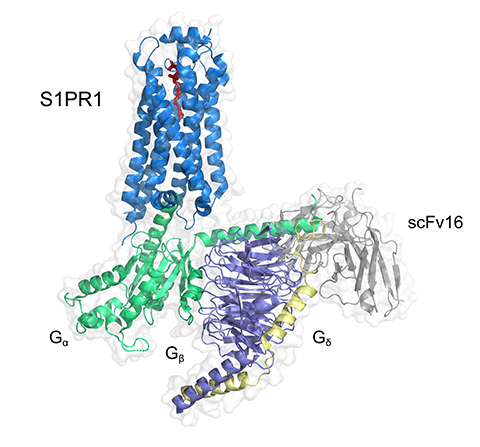From the journals: JLR
A clickable molecule to study S1P metabolism. How HDL subtypes are isolated can change their function. Seipin’s role in steroid synthesis. Read about these papers recently published in the Journal of Lipid Research.
A clickable molecule to study S1P metabolism
The lipid known as sphingosine-1-phosphate, or S1P, functions as a metabolic intermediate and a cellular signaling molecule. It exerts most of its known actions primarily by interacting with a family of five specific G protein–coupled receptors, or GPCRs, called S1P receptors 1-5, which are among the most abundant and widely expressed GPCRs in humans and are present in high concentrations in the immune and vascular systems.

Receptor-mediated S1P signaling is critical in regulating physiological processes such as growth, survival, migration and cell apoptosis. Because diseases such as cancer, diabetes and obesity are linked to the unbalanced metabolism and defects in the S1P signaling pathway, studying the S1P metabolism and its intracellular tracking helps researchers understand these disorders and develop therapeutic strategies.
Researchers can use S1P analogs containing small functional groups such as azides or alkynes that they can label with click chemistry to add sensitive tags to study the cellular metabolism of S1P. As azides and alkynes are rare in nature, click reactions can be performed on these analogs quickly and selectively in the presence of other functionalities that exist in biological systems. The corresponding S1P metabolites and the interacting proteins then can be identified and quantified using techniques such as fluorescence microscopy or mass spectrometry.
Christine Sternstein and a team at the University of Wuerzburg synthesized a new azido-functionalized S1P derivative that can be labeled via click chemistry with alkyne-substituted molecules. This clickable S1P derivative with a terminal azido group activated the S1P receptors similarly to S1P. The researchers carried out a successful staining experiment using this S1P analog with a bright fluorophore dye to visualize the distribution of S1P metabolites inside the cells, providing a powerful new tool for studying the cellular metabolism of S1P. The researchers’ article on this study recently was published in the Journal of Lipid Research.
Isolating HDL subtypes
High-density lipoprotein, or HDL, particles help transport lipids through extracellular fluids of the body and are notable for scavenging excess cholesterol from cells in reverse cholesterol transportation to the liver. This decreases the accumulation of atheromatous plaque within the walls of arteries. Thus, the higher concentration of HDL particles in the blood often is associated with a reduced risk of sudden plaque ruptures, cardiovascular disease and other disorders.
The relationship between HDL structure and function appears to depend, in part, on its protein composition, so accurate characterization of HDL particles will lead to better understanding of their various functions and disease states. This characterization starts with isolating the particles from body fluids.
Michael Holzer and Senka Ljubojevic–Holzer at the Medical University of Graz worked with an international team to determine whether the choice of isolation technique influences the protein composition of the isolated particles. They found that three common methods for HDL isolation — immunoaffinity, density gradient ultracentrifugation and dextran sulfate precipitation —changed the type of HDL particles isolated and their functions.
These results, which the team describes in an article in the Journal of Lipid Research, will help researchers develop methods to isolate specific subtypes of HDL particles and compare, replicate and analyze proteomic HDL data.
Seipin’s role in steroid synthesis
Steroid hormones include glucocorticoids, which regulate metabolism and immune function; mineralocorticoids, which help maintain blood volume and control renal excretion of electrolytes; and sex hormones, which are needed for sex differentiation in males and support reproduction.
These hormones are biosynthesized from cholesterol in the steroidogenesis tissues in the adrenal gland and gonads. Cholesterol from cholesteryl ester–rich lipid droplets, or CE-rich LDs, taken up from plasma is most important when steroidogenic cells are stimulated for an extended time. This hormone biosynthesis also requires a battery of oxidative enzymes in both mitochondria and the endoplasmic reticulum, or ER. Malfunctions of this pathway lead to disorders of sex development and salt–water balance.
Seipin is an ER protein that forms oligomeric complexes at ER–LD contact sites, and its deficiency severely alters LD maturation and morphology as seen in Berardinelli–Seip congenital lipodystrophy type 2. To learn about the role of seipin in CE-rich LD accumulation in steroidogenic tissues and steroid synthesis, Wen-Jun Shen from Stanford University and ateam of collaborators generated mice with deficient expression of seipin, specifically in tissues of the adrenal gland, testis and ovary that normally accumulate CE-rich LDs. According to their finding published in the Journal of Lipid Research, LD and CE accumulation in the adrenals of the seipin-deficient mice was markedly reduced, showing that seipin plays a pivotal role in intracellular cholesterol trafficking.
Enjoy reading ASBMB Today?
Become a member to receive the print edition monthly and the digital edition weekly.
Learn moreGet the latest from ASBMB Today
Enter your email address, and we’ll send you a weekly email with recent articles, interviews and more.
Latest in Science
Science highlights or most popular articles

Decoding microglial language
Emory University scientists characterize extracellular vesicles that facilitate intercellular communication.

What is metabolism
A biochemist explains how different people convert energy differently – and why that matters for your health.

What’s next in the Ozempic era
Diabetes, weight loss and now heart health: A new family of drugs is changing the way scientists are thinking about obesity — and more uses are on the horizon.

How a gene spurs tooth development
University of Iowa researchers find a clue in a rare genetic disorder’s missing chromosome.

New class of antimicrobials discovered in soil bacteria
Scientists have mined Streptomyces for antibiotics for nearly a century, but the newly identified umbrella toxin escaped notice.

New study finds potential targets at chromosome ends for degenerative disease prevention
UC Santa Cruz inventors of nanopore sequencing hail innovative use of their revolutionary genetic-reading technique.

